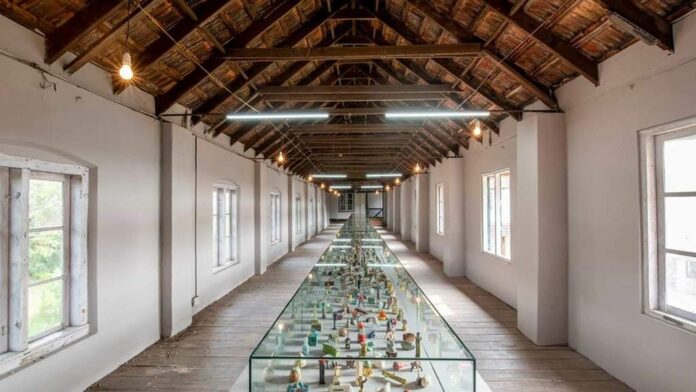Kochi-Muziris Biennale seeks to invoke the historical cosmopolitan legacy of the modern metropolis of Kochi, and its mythical predecessor the ancient port Muziris.
India’s first international contemporary visual arts festival
Kochi Biennale Foundation
1/1903, Kunnumpuram
Fort Kochi PO
Kerala 682001
India
T: +91 484 2215297
F: +91 484 2215287
[email protected]
www.kochimuzirisbiennale.org
Kochi-Muziris Biennale is India’s first-ever international contemporary art biennial, and its story is unique to India’s current reality—its political, social, and artistic landscape. It began as a government initiative when the Department of Cultural Affairs of the Government of Kerala approached two artists—Riyas Komu and Bose Krishnamachari—to help organize an international platform for art in India. The challenge was proportionate to the ambition of the project. A biennial had never gotten past the conceptual stage in India before. No existing infrastructure was necessary for an exhibition of this scale—no spaces and no institutional support structures.
KBF was established in 2010 by Artists for Artists as a non-profit charitable trust in Kerala, South India, to promote art, culture, heritage, and education. The Government of Kerala has been a principal supporter of the Kochi Biennale Foundation.
KBF promotes artistic and cultural education through engagement and dialogue with diverse and inclusive art practices and exhibitions. KBF aims to catalyze Kochi and its surroundings with contemporary art and ideas, work towards the restoration and conservation of heritage properties and monuments, and revive traditional forms of art and culture.
KBF hosts the Kochi-Muziris Biennale (KMB), India’s largest contemporary art festival, presented biennially in the historic port city of Kochi, on the Malabar coast of India.
KMB draws from Kerala’s rich multicultural history, including the fabled Chera harbor of Muziris, which traded with the Middle East, North Africa, and the Mediterranean regions. In the recent past, Kochi was ruled and influenced by the Portuguese, Dutch, and British colonial cultures and has been home to a number of ethnic communities, including Jews, Konkinis, and Gujaratis.
With the support of the government, private patrons, and local businesses, the Biennale found the spaces and opened them up for art. The Indian art community has been growing rapidly and emerging onto the world stage, and the international arts community offered their support in sending art and artists to participate in Kochi. Artists became the spokespersons and activists for the Biennale.
The Kochi-Muziris Biennale seeks to invoke the latent cosmopolitan spirit of the modern metropolis of Kochi and its mythical past, Muziris. It will create a platform that will introduce contemporary international visual art theory and practice to India, showcase and debate new Indian and international aesthetics and art experiences, and enable a dialogue among artists, curators, and the public.
The Kochi-Muziris Biennale seeks to create a new language of cosmopolitanism and modernity rooted in the lived and living experience of this old trading port, which has been a crucible of numerous communal identities for more than six centuries. Kochi is among the few cities in India where pre-colonial traditions of cultural pluralism continue to flourish. These traditions pre-date the post-Enlightenment ideas of cultural pluralism, globalization, and multiculturalism. They can be traced to Muziris, the ancient city buried under layers of mud and mythology after a massive flood in the 14th century. The site was recently identified and is currently under excavation. It is necessary to explore and, when required, retrieve memories of this past and its present in the current global context to posit alternatives to political and cultural discourses emanating from the specific histories of Europe and America. A dialogue for new aesthetics and politics rooted in the Indian experience but receptive to the winds blowing in from other worlds is possible.
The Kochi-Muziris Biennale seeks to establish itself as a center for artistic engagement in India by drawing from the rich tradition of public action and public engagement in Kerala, where Kochi is located. The emergence of Kerala as a distinct political and social project with lessons for many developing societies also owes to aesthetic interventions that have subverted notions of social and cultural hierarchies. These interventions are inherent in our rich arts tradition’s numerous genres and practices. In a world of competing power structures, it is necessary to balance the interests and independence of artists, art institutions, and the public.
The Kochi-Muziris Biennale seeks to reflect the new confidence of Indian people who are slowly but surely building a new society that aims to be liberal, inclusive, egalitarian, and democratic. The time has come to tell the story of cultural practices distinct to the Indian people and local traditions, practices, and discourses that are shaping the idea of India. These share a lot with the artistic visions emerging from India’s neighborhood. The Biennale also seeks to project the new energy of artistic practices in the subcontinent.
The Kochi-Muziris Biennale seeks to explore the hidden energies latent in India’s past and present artistic traditions and invent a new language of coexistence and cosmopolitanism that celebrates people’s multiple identities. The dialogue will be with, within, and across identities fostered by language, religion, and other ideologies. The Biennale seeks to resist and interrogate representations of cosmopolitanism and modernity that thrive by subsuming differences through co-option and coercion.
The Kochi-Muziris Biennale seeks to be a project in appreciation of, and education about, artistic expression and its relationship with society. It aims to be a new space and a fresh voice that protects and projects the autonomy of the artist and her pursuit to constantly reinvent the world we live in.
The Kochi Biennale Foundation is also engaged in conserving heritage properties and monuments and uplifting traditional forms of art and culture. The Foundation was founded in 2010 by artists Bose Krishnamachari and Riyas.
The festival aims to stimulate national tourism, cultural interest and social cohesion. In collaboration with the Kerala Tourism Department, local and national stakeholders and creative industries, the Biennale will do this through:
- developing cultural and social awareness through education
- developing visual arts practices and theory in Kochi and India
- developing cultural tourism by attracting national and international visitors to the festival engaging with the local communities
- becoming a catalyst for regeneration and urban development
The official Declaration launch of the Biennale was held at Durbar Hall Ground, Kochi, on Thursday 17 February 2011, 6pm. The event was officially declared by the then Minister of Education and Culture Mr. M. A. Baby in the presence of ministers, senior government officials, senior artists, scholars, critics and the public. The launch was followed by a performance by the band Avial, and Panchari Melam by Padmashri Peruvanam Kuttan Marar, supported by 180 artists, in a live audio‐visual percussion concert.
Partly funded by the state government, the project presents a number of opportunities for corporations, both international and regional, to promote their brands across various activities of the Biennale. The foundation welcomes interest from companies looking to support a cultural initiative from its inception and a team is in place to customise a sponsorship package tailored to individual needs and budgets.
NOTES FOR EDITORS
Kochi‐Muziris Biennale is being organised by Kochi Biennale Foundation, a registered Trust established in 2010, founded by leading Kerala artists Bose Krishnamachari and Riyas Komu.
The other trustees of the Foundation are:
- Dr. Venu V, Secretary, Department of Tourism, Government of Kerala
- Sajan Peter, Secretary, Department of Cultural Affairs, Government of Kerala
- Rani George, Director, Department of Tourism, Government of Kerala
- P. K. Hormis Tharakan, former chief, RAW, former National Security Advisory Board member, former DGP
- K. Subhas Chandran, former Director (programmes), NCPA, Mumbai
- Jose Dominic, Managing Director, CGH Earth
- Sunil V, Creative Director, Wieden + Kennedy
- Bonny Thomas, writer/cartoonist.
Bose Krishnamachari (Artistic Director of the inaugural Biennale)
Born 1963, Kerala. Lives and works in Mumbai.
Artist and curator Bose Krishnamachari has a diverse artistic and curatorial practice that includes drawing, painting, sculpture, photography, furniture, design, video installation and architecture. His artistic endeavors plumb creative depths to give contemporary Indian art a nouvelle direction.
Krishnamachari has exhibited in several important solo and group exhibitions including ‘Gateway Bombay’ at the Peabody Essex Museum (USA, 2007), ‘Indian Highway’ at the Serpentine Gallery, The Astrup Fearnley Museum in Norway (Oslo, Norway, 2009), the Herning Museum of Contemporary Art in Denmark, the Lyon Contemporary Art Museum (France, 2011) and has an upcoming exhibition at the MAXXI museum for contemporary art, Rome. His curatorial projects include the seminal exhibition ‘The Bombay Boys’ (Delhi, 2004), the travelling project, ‘Double-Enders’ (2005), LaVA (Laboratory of Audio Visual Arts) (2007) and ‘guest curator’ at the Indian pavilion of ARCO-Madrid (Spain, 2009). In 2009 Krishnamachari created Gallery BMB in South Mumbai with a vision to bring the best national and international art to India.
Riyas Komu (Director of Programmes of the inaugural Biennale)
Born in 1971, Kerala. Lives and works in Mumbai and Kerala.
Riyas Komu’s critically acclaimed works have been exhibited extensively in India and abroad, which include several key works that focus on the political and cultural history of Kerala. His works are part of the larger narrative of the making and unmaking of artistic influences.
In 2007 he was one of two artists from India to be selected by curator Robert Storr for the Venice Biennale. Recent exhibitions include shows at the GEM Museum for Contemporary Art (The Hague, The Netherlands 2009), The Astrup Fearnley Museum of Modern Art (Oslo, Norway, 2009), the Shanghai Museum of Contemporary Art (Shanghai, China, 2009) and the Gwangju Emerging Asian Artists Exhibition (Gwangju, Korea, 2010). He is the first Indian artist to hold a solo exhibition in Iran (Azad Art Gallery, 2010). Significant works focusing on football include ‘Mark Him’, with the Indian National Football team and ‘Left Legs’ with the Iraqi National Football team (2008/2010). His work is currently on view at the Centre Pompidou, Paris, France, as part of their ‘Paris-Delhi-Bombay’ exhibition.
Source: https://www.neme.org/blog/kochi-muziris-biennale-2012




